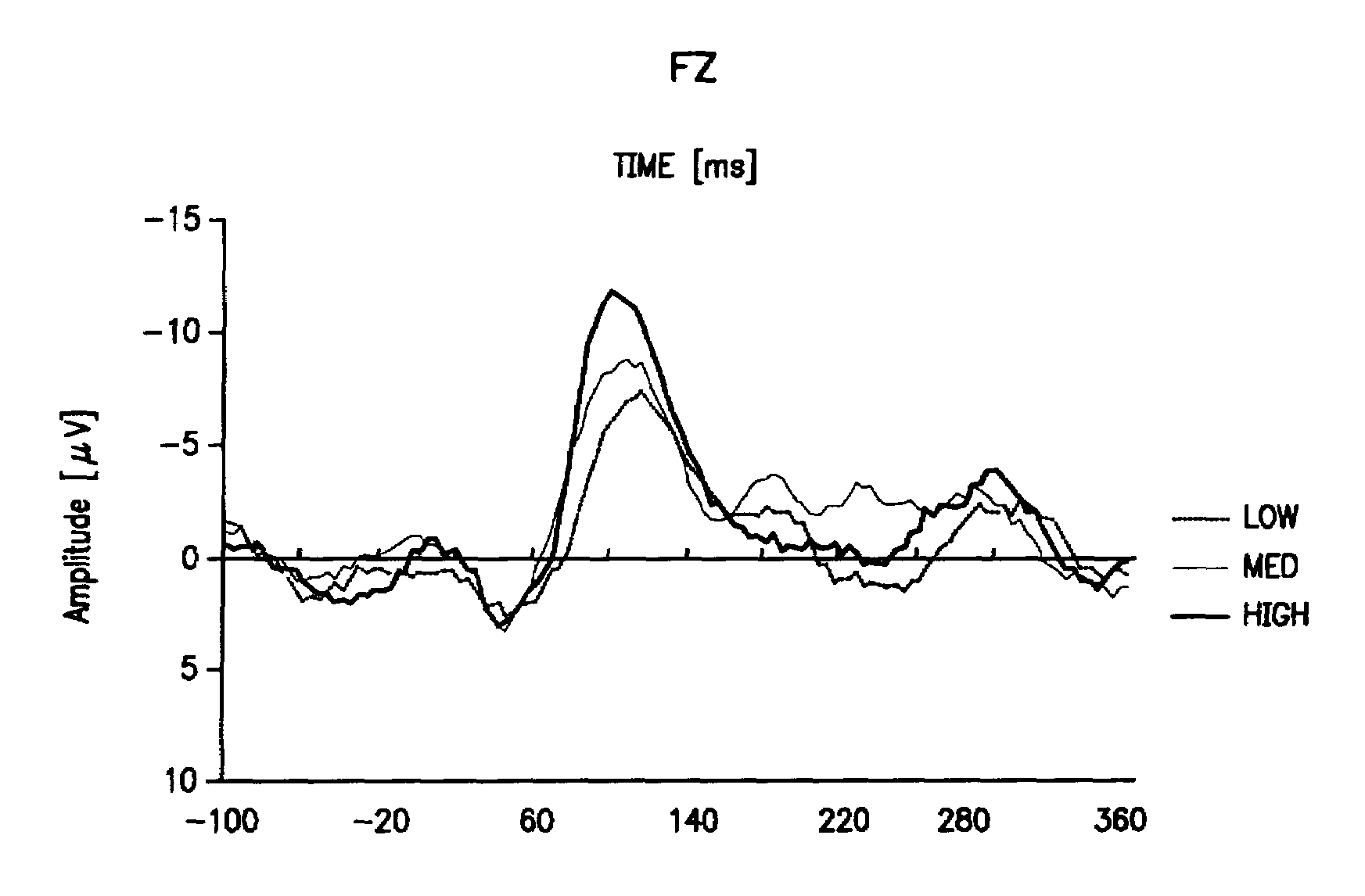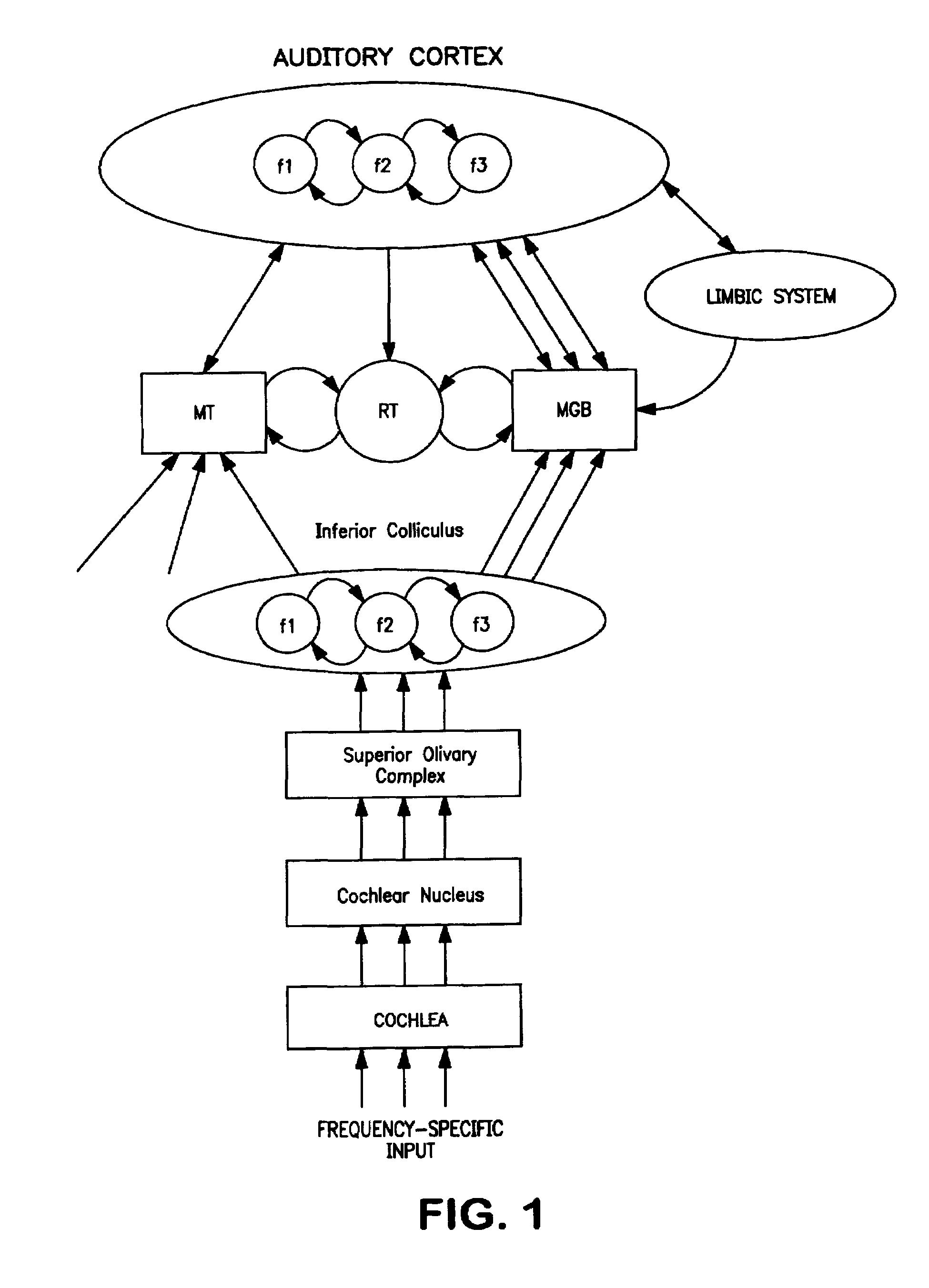EEG feedback controlled sound therapy for tinnitus
a feedback controlled and tinnitus technology, applied in the field of tinnitus diagnosis and treatment, can solve the problems of imbalance of input, tinnitus to fire, and set off the thalomocortical reverberating loop, and achieve the effect of increasing the sound intensity
- Summary
- Abstract
- Description
- Claims
- Application Information
AI Technical Summary
Benefits of technology
Problems solved by technology
Method used
Image
Examples
example i
[0054]Tinnitus Causes Specific Changes to the Augmenting / Reducing Response
[0055]As Inventors have discovered in their own laboratory and has been shown elsewhere, tinnitus increases the slope of the AR response of the N100 component of the auditory evoked potential [Norena et al, 1999]. Furthermore, it has also been shown by means of magnetic source imaging that tinnitus induces tonotopically organized activity in the auditory cortex [Mühlnickel et al, 1998]. It was therefore hypothesized that the AR response at the specific frequencies at which tinnitus is perceived will have a steeper slope. Tinnitus patients match the pitch of their tinnitus to the frequency of a pure tone. The auditory evoked potential to a variety of tone pitches, including the tinnitus pitch, is then be recorded from patients and normal controls. The magnitude of N100 responses allows Inventors to calculate the slope of the AR response for tinnitus frequency tones, as well as for frequencies not related to tin...
example ii
EEG Index of Tinnitus
[0116]Inventors determined whether N100 intensity dependence (i.e., the changes in amplitude in this brain signal as a function of stimulus intensity) differs in tinnitus sufferers compared to non-tinnitus control subjects. The experiment thus far has involved 24 tinnitus subjects and 14 control subjects. Tinnitus subjects were initially asked to match the pitch of their internal tinnitus to the frequency of a sine tone. Auditory ERPs in response to tones of up to four frequencies were recorded. For the non-tinnitus control subjects, these frequencies were 1 kHz, 2 kHz, 4 kHz and 8 kHz. In tinnitus subjects, their own tinnitus frequency was substituted for one of the frequencies used with the control subjects. For all subjects, tone pips were presented at intensities of 30 dB SL, 36 dB SL, 42 dB SL, 48 dB SL and 54 dB SL. The peak amplitudes of the N100 component were then measured and plotted as a function of stimulus intensity. A linear regression was calculat...
example iii
Customized Habituation Therapy with Habituation Stimuli
[0119]Although their judgements are necessarily subjective, tinnitus subjects have evinced excellent consistency when it comes to matching habituation sounds with their tinnitus. Before beginning the habituation therapy, Inventors required subjects to confirm that the habituation sound matched their tinnitus at two or more sessions separated by at least a week. While there is some evidence that adjustments in the habituation stimulus may be desirable after habituation has progressed a few weeks, it seems reasonably clear, that this is due to changes in the characteristics of the tinnitus itself rather than a mismatch in the habituation sounds. The frequency content of a typical habituation stimulus is shown in FIG. 7.
[0120]Tinnitus retraining therapy requires habituation to constant noise exposure. In order for habituation to occur, the habituation stimulus has to be audible, but must not be so loud as to mask the tinnitus [Jast...
PUM
 Login to View More
Login to View More Abstract
Description
Claims
Application Information
 Login to View More
Login to View More - R&D
- Intellectual Property
- Life Sciences
- Materials
- Tech Scout
- Unparalleled Data Quality
- Higher Quality Content
- 60% Fewer Hallucinations
Browse by: Latest US Patents, China's latest patents, Technical Efficacy Thesaurus, Application Domain, Technology Topic, Popular Technical Reports.
© 2025 PatSnap. All rights reserved.Legal|Privacy policy|Modern Slavery Act Transparency Statement|Sitemap|About US| Contact US: help@patsnap.com



